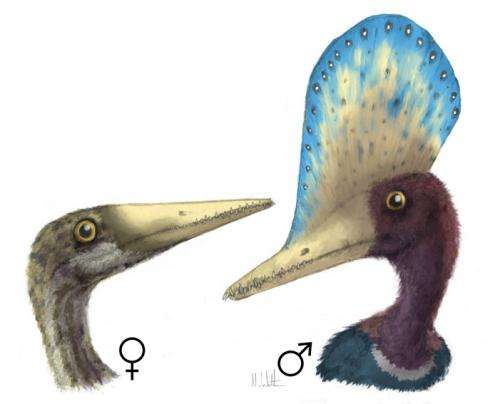Survival of the prettiest: Sexual selection can be inferred from the fossil record

Detecting sexual selection in the fossil record is not impossible, according to scientists writing in Trends in Ecology and Evolution this month, co-authored by Dr Darren Naish of the University of Southampton.
The term "sexual selection" refers to the evolutionary pressures that relate to a species' ability to repel rivals, meet mates and pass on genes. We can observe these processes happening in living animals but how do palaeontologists know that sexual selection operated in fossil ones?
Historically, palaeontologists have thought it challenging, even impossible, to recognise sexual selection in extinct animals. Many fossil animals have elaborate crests, horns, frills and other structures that look like they were used in sexual display but it can be difficult to distinguish these structures from those that might play a role in feeding behaviour, escaping predators, controlling body temperature and so on.
However in their review, the scientists argue that clues in the fossil record can indeed be used to infer sexual selection.
"We see much evidence from the fossil record suggesting that sexual selection played a major role in the evolution of many extinct groups," says Dr Naish, of the University's Vertebrate Palaeontology Research Group.
"Using observations of modern animal behaviour we can draw analogies with extinct animals and infer how certain features improve success during courtship and breeding."
Modern examples of sexual selection, where species have evolved certain behaviours or ornamentation that repel rivals and attract members of the opposite sex, include the male peacock's display of feathers, and the male moose's antlers for use in clashes during mating season.
Dr Naish and co-authors state that the fossil record holds many clues that point to the existence of sexual selection in extinct species, for example weaponry for fighting, bone fractures from duels, and ornamentation for display, such as fan-shaped crests on dinosaurs. Distinct differences between males and females of a species, called 'sexual dimorphism', can also suggest the presence of sexual selection, and features observed in sexually mature adults, where absent from the young, indicate that their purpose might be linked to reproduction.
We can also make inferences from features that are 'costly' in terms of how much energy they take to maintain, if we assume that the reproductive advantages outweighed the costs.
Whilst these features might have had multiple uses, the authors conclude that sexual selection should not be ruled out.
"Some scientists argue that many of the elaborate features on dinosaurs were not sexually selected at all," adds Dr Naish, who is based at the National Oceanography Centre, Southampton.
"But as observations show that sexual selection is the most common process shaping evolutionary traits in modern animals, there is every reason to assume that things were exactly the same in the distant geological past."
More information: Knell, R. et al. Sexual selection in prehistoric animals: detection and implications, Trends in Ecology & Evolution, Volume 28, Issue 1, January 2013, Pages 38-47, doi: 10.1016/j.tree.2012.07.015
Journal information: Trends in Ecology and Evolution
Provided by University of Southampton



















